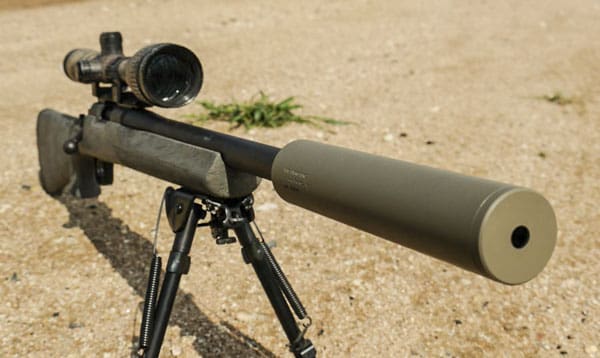
If there’s one universal problem with silencers it’s this: cost. Suppressors here in the United States have traditionally been much more expensive than their European counterparts because given the time and money it takes to obtain one ($200 in taxes plus a ton of paperwork) people tend to only want to buy one silencer and use it for the rest of their life, rather than the somewhat more “disposable” versions that are prevalent overseas. One company in Texas, Duke Suppressors, asked the question, “why not make them both inexpensive and durable?” Their answer is available right now in 7.62 and 5.56 diameter flavors.
I spent some time with the owner of Duke Suppressors out at the range recently to test out their line of cans and also take a peek at what they have coming down the road. While it was a great look at their line and I got some good info on the company, it wasn’t quite enough for a full-on review. We’ll get some models in for proper testing, but for now this is a good first look.
Duke Suppressors was started back in 2014. Having done aerospace engineering and machine work for years, they were looking for something new and interesting to devote their available machining hours toward. Looking at the market they saw a ton of high end silencers, but not much that the average person could afford and slap on their rifle. So they set out to create a can that was built like a tank yet still offered affordable rifle suppression for the average shooter.
The company designed and perfected their cans over a two-year period. The 5.56 model alone was built using 44 different versions, metering each one to try and identify the best design possible given the constraints. At the end of the process they had two cans — a 5.56 model and a 7.62 — both of which are full auto rated yet can be disassembled for cleaning.
The .30 caliber silencer is definitely what I would term a “chunky monkey.” Tipping the scales at 24.1 ounces (four ounces heavier than the old AAC 762-SDN-6) the can will definitely be felt on the end of any rifle. That said, if you’re sweating about a couple extra ounces given the price point then you probably aren’t in the target demographic. MSRP on the 7.62 suppressor is $430, which makes it a less expensive option than anything comparable listed on Silencer Shop’s site.
But wait, there’s more! Not only is it an inexpensive 7.62 silencer, but it’s also been tested up to and including .300 Winchester Magnum. That’s something not many other low priced options can boast.
Over on the 5.56 side, their can also has some nice features. Less than an ounce lighter than the 7.62 version, the 300 Stainless Steel silencer is full auto rated and available for the low low price of $395. What makes this particularly appealing is that not only can you run the can on your centerfire rifles, but you can also run any rimfire cartridge you want through it and still be able to take it apart for cleaning.
Out on the range the cans performed admirably. They reduced the muzzle report from a .300 BLK rifle and a 5.56 AR-15 to roughly hearing safe levels, and despite their weight, they didn’t detract all that much from the balance of the rifle. Honestly I don’t have any complaints about their performance.
The one criticism I have of their cans is that there’s no ability to change the rear end cap. Most modern silencers have the ability to swap out the rear of the can to adjust for whatever thread pitch of your rifle, whether it’s 1/2×28 or 5/8×24 or 14.1 metric left hand. With Duke’s cans you’re stuck with the thread pitch they come from the factory. Then again, given the price point I’m not all that bummed about the situation.
Overall the cans are great. The build quality seems solid, and the price is attractive. For those interested in dipping their toe into the world of suppressed shooting these are a good starting point — both versatile and inexpensive. We’ll get our hands on some samples for longer term testing and report back with the results.

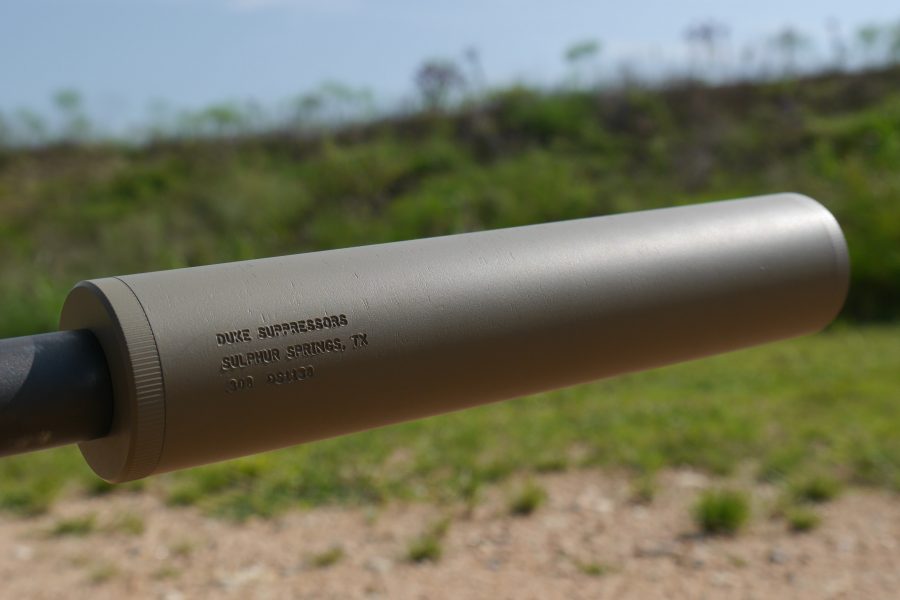

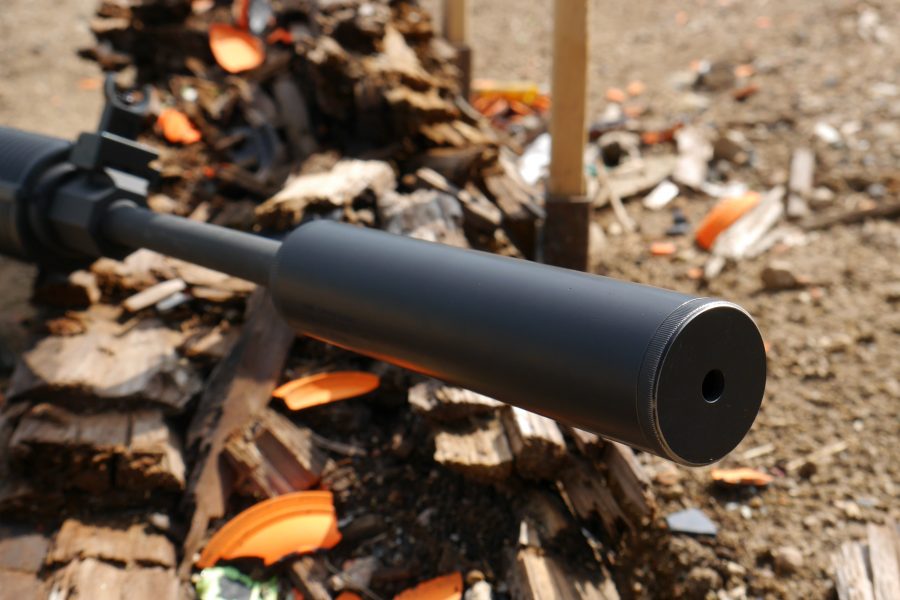
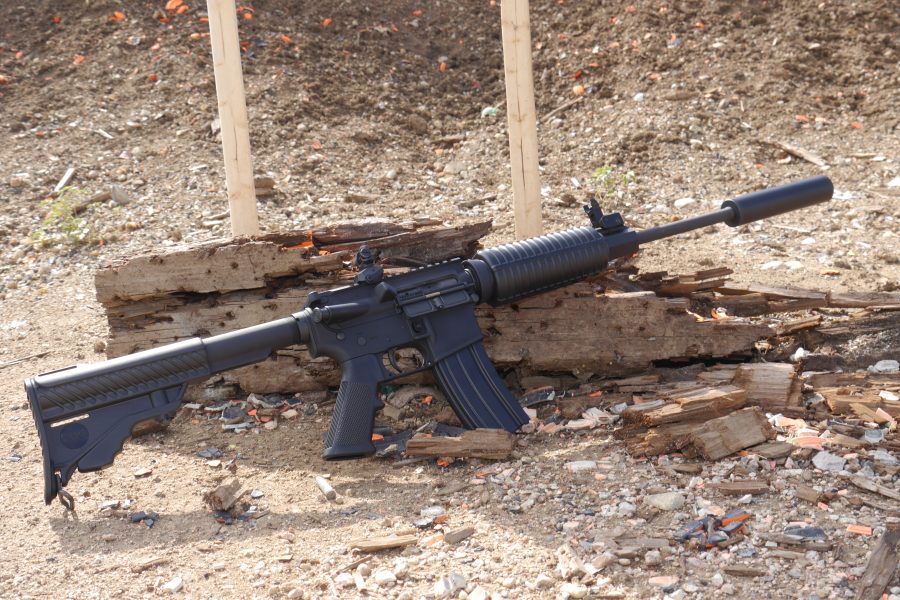


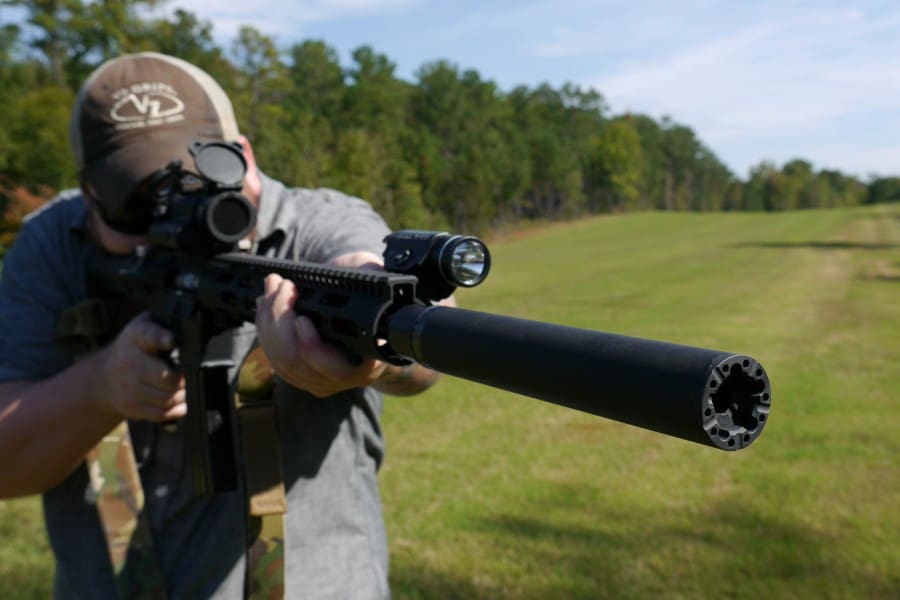
accuracy tests????
WOO!
Check out Rebel Silencers!
The biggest issues with suppressors is the NFA. $200 bucks each and the absurd wait times. Repeal the NFA.
I agree, repeal all of the NFA…
But as far as an achievable plan, at least pass the Hearing Protection Act, and remove silencers from the NFA. Then start working on the rest of the unconstitutional law. At a minimum, closing off the machine gun registry should be seen as unconstitutional.
It’s hard and it sucks, but having done it a few times it’s totally worth it. It bums me out when I hear people talking about how they’d absolutely buy a suppressor today if they didn’t have to wait…they have the funds, they have the desire, but they aren’t willing to plop down the money and not have anything to show for it for the better part of a year. I absolutely understand that, but the payoff is there at the end. Shooting suppressed is so dang enjoyable.
BTW I’m still waiting and expecting to see manufacturers and retailers offering payment plans to ease that pain of paying up front for something you can’t use for so long regardless. Not “layaway” in the traditional sense of doing it because the person can’t afford it and needs help committing to ‘saving’ that money for it, but just to help alleviate the mental aggravation factor of spending many hundreds or, often, over a thousand dollars nearly a year in advance of getting the product, which you have to wait the same amount of time for whether you pay for it up front or not. Time value of money and all, it’s painful. Spreading it out into 9 or 10 payments might make it mentally easier for many folks to take that leap.
It’s more than the wait and the big tax bite.
It’s not wanting to be on yet another government list.
It’s not wanting to have to carry the super special documents around everywhere the suppressor goes.
It’s not wanting to have to check the different state laws before traveling.
Sure you have to do some of these things as a gun owner but the gun is essential, a suppressor is not.
^ This times eleventy billion!!!
You just described why I will not own one.
Keeping the documents isn’t a big deal, especially since the AFT issued digital only “stamps”.
I keep mine on an online drive that I can access from any smart phone or computer. Only the ATF can demand to see your paperwork anyway. And as my SOT said, if they are asking for your paperwork, you are already f***ed. Time to lawyer up.
It may be helpful to show it to an NFA ignorant local LEO, but they aren’t really going to know what they are looking at anyway.
Obviously we’re well into subjective, personal opinions now and yours are as valid as mine and y’all are making a choice to avoid buying a suppressor for logical reasons. My feelings on the things you mentioned, though, for my situation…
“It’s not wanting to be on yet another government list.”
* no argument there, really. Personally I know I’m on enough “lists” already that it didn’t make any difference to me to put NFA items on a trust and be a trustee of that trust. Of course, it’s a little different now that trusts require personal vetting, but as a previous, firearms-owning resident of California and now one of Washington (and WA does keep a record of handgun sales) who submits to NICS checks freaking constantly and has a monthly shooting range membership billed to a credit card, etc etc, they know who I am and that I have guns. Having NFA items doesn’t change a darn thing about that, despite what a lot of people mistakenly believe about random inspections (not a real thing unless you’re an FFL) or other forfeiture of any civil liberties and rights at all due to owning NFA items.
“It’s not wanting to have to carry the super special documents around everywhere the suppressor goes.”
* “have to” is strongly phrased. While it’s pretty much universally-suggested, you only have to retain a copy of your approval (“proof of registration”) and make it available for inspection should an ATF agent request that. It doesn’t state that you must have the doc with you and be able to show it instantly. Of course, it’s easier if you can show it instantly. I keep PDF copies on my phone (backed up in the cloud, as VT mentioned). I’ve seen guys scan their forms, shrink them down to business card size, and print ’em that size. Or fold the form up and put it inside the pistol grip of their SBR. Or just keep an envelope with them in their range bag. Lots of easy, acceptable options. It’s typically just a single page per registered item. I realize this is an extra step, but it’s a small barrier to entry. I already always carry a driver’s license, concealed pistol license, health insurance card, proof of car insurance and registration in all of my vehicles (which is most akin to proof of NFA registration, except you only pay once and it’s good for life), etc. anyway. This is one more in a long list that nobody ever thinks twice about, and acting like this particular one is the straw that breaks the camel’s back is a bit disingenuous or at least hyperbolic, IMHO. It’s a file on my phone. Easy.
“It’s not wanting to have to check the different state laws before traveling.”
* this is actually easier for a suppressor than for a firearm and much easier than for carrying a firearm. Can you bring your suppressor? https://s3.amazonaws.com/com.silencerco/wp-content/uploads/2016/07/07153523/ownermap.png <<< there's the answer. Done. Figuring out if you can carry somewhere requires checking to see if the state recognizes your CCW permit(s), then reading up on that state's carry laws to determine where/when you can't carry (in a restaurant that serves alcohol? In a bar? Can I have a beer or not? Do I have an obligation to inform a police officer that I'm carrying or not? In school zones? In sporting venues? At a concert? In a mall? In a park? Do "no gun" signs carry the force of law or not?). Are there "features" of a gun that make it illegal to have in the state or jurisdiction? Can you have a loaded rifle in the trunk of a car? What does the state define as "loaded?" Anyway there's a shit ton of stuff to research if you're worried, whereas suppressors are either legal or not and that's really the end of it.
Obviously the basic fact that they're restricted is frustrating and stupid. They're harmless safety devices, and basically everywhere else in the world treats them as such. We've all seen those foreign eBay listings in places like New Zealand selling suppressors for a couple dollars (like, literally, under $10) because they're nothing more than an 'over-the-counter' tube of metal and you can buy one as easily as you can buy a stapler. But, working with what we're forced to work within, the worst part is the wait. It's otherwise sort of like owning a dirt bike or something, where you similarly have to register it, be able to show proof of that, etc. It isn't that onerous; it's just one more in a long list (and a simple one, at that).
Capitol Armory in Texas has a payment plan.
It’s not about the fucking money. It’s the burdensome taxation and the process!
if you have a good relationship with an LGS many times they have no problem putting a can aside in order to expedite the paperwork. Mine has done that several times.
Any info on distribution? Not much on the website yet…
They are about 4 months late to the show…
Can someone please explain how they can ask even $400 with a straight face? A suppressor is infinitely more simple than a complete rifle or shotgun and yet manufacturers offer complete rifles and shotguns for under $300.
Assuming a manufacturer was going to manufacture 50,000 or more suppressors, the material cost of a suppressor has to be less than $5 for plain steel and $10 for stainless steel. The machining costs have to be less than $10. And administrative costs have to be less than $10.
That all adds up to $25 to $30. Why isn’t anyone offering these for sale for $100????? At that price point, I am pretty confident that a manufacturer would easily sell more than 50,000 units, in spite of the NFA requirements. More importantly, we would have a much easier time demonstrating that the $200 suppressor tax, which would be twice the cost of the suppressor, was obviously a discriminatory/oppressive measure intended to prevent people from acquiring suppressors rather than a tax. And that would hopefully go a long way to giving the courts the proper reasoning to strike down the suppressor portion of the NFA law.
Development cost is very large.
I believe you are way underestimating the machining time and the materials are usually more exotic than stainless steel to reduce weight without reducing durability.
It is a huge risk to put in all the engineering work for a $100 product (that your consumer has to pay 300 for and wait 6 months) for an optimistic profit of like 10-20 bucks a unit or 500k-1 million in profit for 50,000 units. Even jumping to a $60 profit on each one that still only 3million. The ROI just is not there for equipment, personnel, and development.
VTaero,
Thank you for the response.
I am still not understanding your description of the business model. A suppressor is simply a tube which has dividers with holes (baffles), a threaded end, and a hole at the far end. The tube should be pre-manufactured round tube stock (cheap), the dividers with holes and the end with a hole should be stamped from flat steel stock with stamped holes (crazy cheap), and the other end should be stamped from flat stock with a stamped hole (crazy cheap) and a threaded connector (costs $2 to machine?). The only somewhat significant machining cost involved is attaching the baffles to the round tube stock which would probably be brazed or welded?
As for “design”, how can that consist of much more than trying a couple different baffle spacings and testing the result?
However you slice it, I just don’t see how a basic suppressor is expensive to “design” or manufacture … especially when you consider that a basic suppressor doesn’t need exotic materials (e.g. titanium) and doesn’t have to produce the absolute lowest sound reduction levels.
Low sales volume, high regulation, high taxes due to all of that regulation (annual licensing taxes, per-unit excise taxes, etc), high legal costs (especially up-front while setting up FFL 07, SOT, ITAR licensing and compliance, etc), high paperwork costs (serialization, sales, and other records keeping requirements), high insurance costs. Plus equipment, various rent- / real estate-related, product development, employment, production, and other costs any manufacturer deals with.
And now you have to sell a product to a consumer who’s dealing with significant barriers to purchasing it. Even a free suppressor costs the consumer $200 for the stamp plus money for fingerprinting, passport photos, possibly fees to the FFL for facilitating, cost for shipping the paperwork, AND a year of his/her time.
Now try to be profitable selling each suppressor for $20 over your materials cost.
BTW that $200 tax has been a $200 tax since 1934, back when you could mail order a firearm for $6 and buy a car for $500.
I would say the one universal problem with them is the NFA circus hoops you have to jump through to get one.
I just did my first NFA item post-change in law, so I had to send notice to my CLEO (SBR). Who called me personally (small town) just to sort of check in. It was all fine, but I don’t want to have to do that too often – I don’t need to be on his radar as the nuttiest gun nut in town.
You guys realize that the $200 tax is lower in real terms than it’s ever been right? It was set that way when the NFA was enacted and has never been adjusted for inflation. If it had been, we’d be paying thousands for that tax stamp by now. Never mind the cost, the real annoyance is all the bureaucracy.
While true, it does not justify its existence nor lessens the stupidity and pain.
Whoa. That thing’s hefty. Most thread-on suppressors are over half a pound lighter than that now. After the tax is thrown in and you find a good street price, it’s not really that much of a difference to go for an established product.
That’s one of the reasons why this silencer is so much cheaper than the competition.
Three words: Mass Civil Disobedience.
Comments are closed.